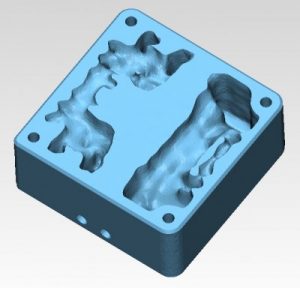Materialise Software Used to Optimize Conformal Cooling Tooling Design of 3D Printed Metal Mold for Toy Car
Research center IPC produces some of the toys for its customer Smoby, and worked with Materialise to lower the cost, and increase the production cycle, for the car by making a lightweight, 3D printed mold with conformal cooling channels built right in. Because these channels follow the shape of the toy car, IPC could ensure that its mold was high performance. The car would take longer to cool down if straight cooling channels were used, and the risk of distortion for the car would also be higher, so conformal channels were used instead.
“For IPC, the main advantage of using metal additive manufacturing to produce tools for plastic injection molding is the possibility to create conformal cooling channels,” Jean-Christophe Bornéat, a Project Manager at IPC, said. “These allow IPC to reduce the production cycle time and improve the part quality.”
IPC used Altair software to perform topology optimization on the car mold, in order to replace some of its solid parts with a more lightweight structure. Then, to smooth the surface of the mold, the Materialise design and engineering team added the results into its 3-matic software, which removed any artifacts and created a 3D model.
Then, taking into account metal 3D printing specs, the open space of the mold was populated with a lattice structure.
“Materialise 3-matic software helps us to replace bulk material with optimized lattice structures,” Bornéat explained. “This replacement reduces the global volume of the mold and so reduces the AM production time, the cost and the residual stresses on the part. These improvements will allow IPC to create larger molds with better return on investment.”
Using 3-matic, Materialise prepared the 3D model of the Lightning McQueen car mold for FEA processing by designing lightweight beams and completing a surface remesh. Then IPC simulated the strength and heat of the model, so Materialise could properly optimize the lattice structure’s build parameters to ensure the proper heat distribution and thickness of the mold.
The slice-based operations of Materialise’s Build Processor software were then called into action to save any information about textures and structures as metadata and apply the 3D geometry at the slicing level only. This allowed IPC to save time by avoiding the STL file stage, which would have been 1,000 to 10,000 times larger and resulted in a far less accurate mold.
 By working together and combining its FEA expertise with Materialise’s metal 3D printing, post-topology optimization, and lattice design know-how, IPC was able to lower the production cycle for Smoby’s toy car by 50%. The lightweight mold made it possible to produce parts with larger dimensions, and the scanning speed was increased, thanks to the use of the lattice structure. Additionally, the lattice also resulted in a reduction of about 18% material usage.
By working together and combining its FEA expertise with Materialise’s metal 3D printing, post-topology optimization, and lattice design know-how, IPC was able to lower the production cycle for Smoby’s toy car by 50%. The lightweight mold made it possible to produce parts with larger dimensions, and the scanning speed was increased, thanks to the use of the lattice structure. Additionally, the lattice also resulted in a reduction of about 18% material usage.
Discuss this story and other 3D printing topics at 3DPrintBoard.com or share your thoughts in the Facebook comments below.
[Source/Images: Materialise]Subscribe to Our Email Newsletter
Stay up-to-date on all the latest news from the 3D printing industry and receive information and offers from third party vendors.
You May Also Like
3D Printing Unpeeled: New Arkema Material for HP, Saddle and Macro MEMS
A new Arkema material for MJF is said to reduce costs per part by up to 25% and have an 85% reusability ratio. HP 3D HR PA 12 S has been...
3D Printing News Briefs, January 20, 2024: FDM, LPBF, Underwater 3D Printer, Racing, & More
We’re starting off with a process certification in today’s 3D Printing News Briefs, and then moving on to research about solute trapping, laser powder bed fusion, and then moving on...
3D Printing Webinar and Event Roundup: December 3, 2023
We’ve got plenty of events and webinars coming up for you this week! Quickparts is having a Manufacturing Roadshow, America Makes is holding a Member Town Hall, Stratafest makes two...
Formnext 2023 Day Three: Slam Dunk
I’m high—high on trade show. I’ve met numerous new faces and reconnected with old friends, creating an absolutely wonderful atmosphere. The excitement is palpable over several emerging developments. The high...




































